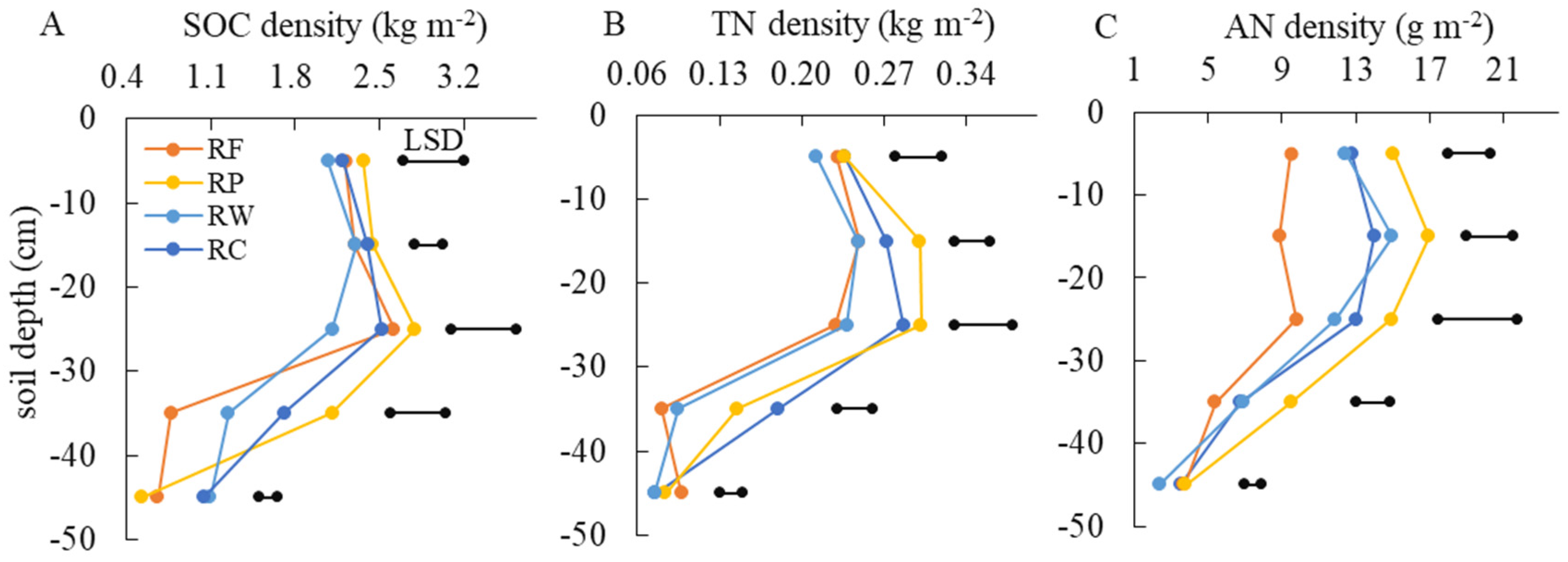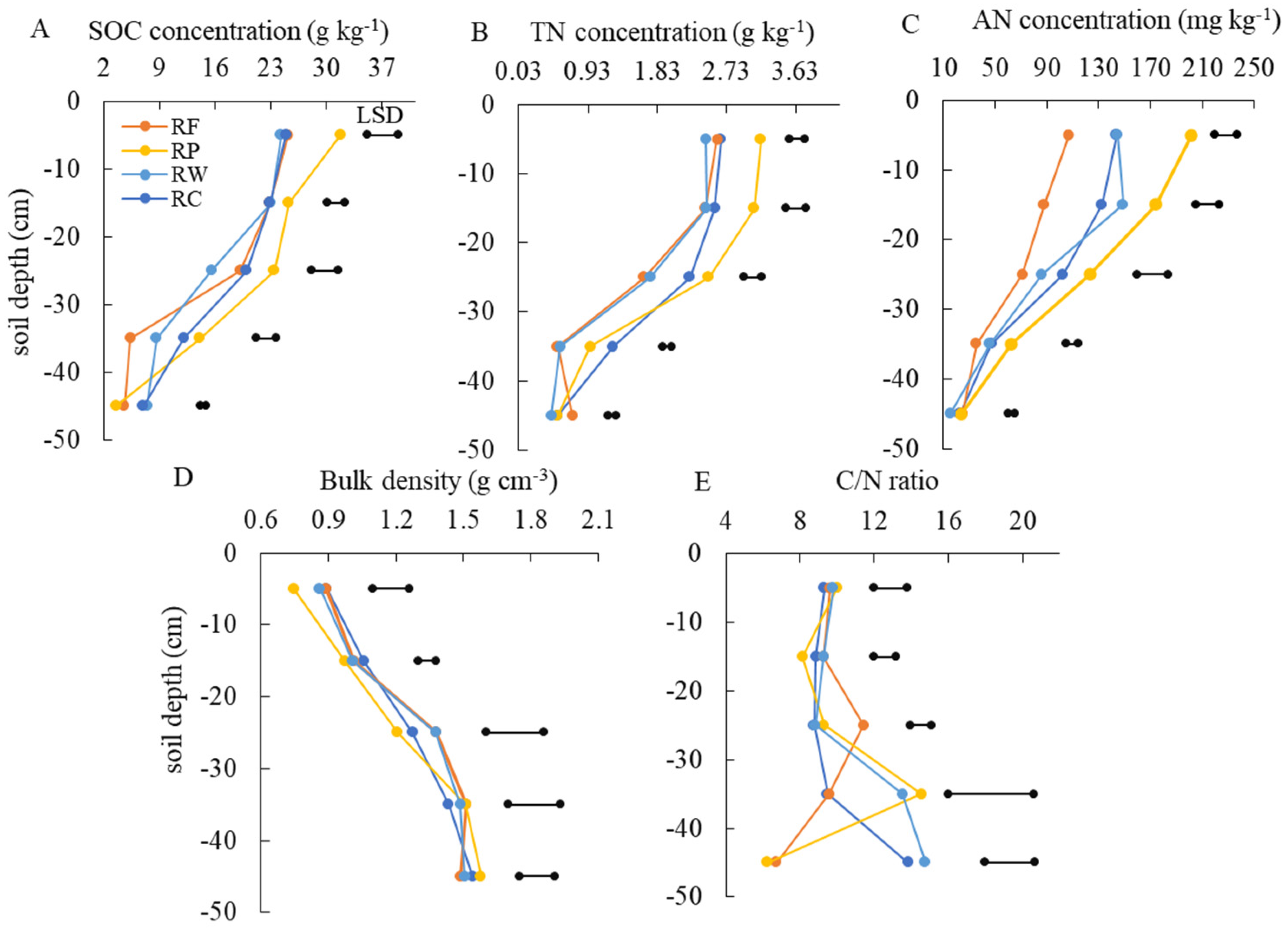Changes in Soil C and N Stocks and Their Effects on Rice Yield under Long-Term Upland-Paddy Rotations
Abstract
1. Introduction
2. Materials and Methods
2.1. Study Site and Experimental Design
2.2. Sampling and Analyses
2.3. Data Analyses
3. Results
3.1. The Differences in the Total Soil C and N Stocks within the 0–50 cm Soil Depth
3.2. Spatial Differences in Soil C and N Stocks
3.3. Stratification Ratios of Soil C and N
4. Discussion
4.1. Differences in Total C and N Stocks in the Top 50 cm Soil Layer among Rotations
4.2. The Distribution Characteristics of Soil C and N at the 0–50 cm Soil Depth
5. Conclusions
Supplementary Materials
Author Contributions
Funding
Data Availability Statement
Conflicts of Interest
References
- Xi, X.H.; Yang, Z.F.; Xia, X.Q.; Li, M. Calculation techniques for soil carbon storage of China based on multi-purpose geochemical survey. Earth Sci. Front. 2009, 16, 194–205. [Google Scholar]
- Sainju, U.M.; Lenssen, A.W.; Allen, B.L.; Stevens, W.B.; Jabro, J.D. Soil total carbon and nitrogen and crop yields after eight years of tillage, crop rotation, and cultural practice. Heliyon 2017, 3, e00481. [Google Scholar] [CrossRef] [PubMed]
- Bauer, A.; Black, A.L. Quantification of the effect of soil organic matter content on soil productivity. Soil Sci. Soc. Am. J. 1994, 58, 185–193. [Google Scholar] [CrossRef]
- Ladha, J.K.; Dawe, D.; Pathak, H.; Padre, A.T.; Yadav, R.L.; Singh, B.; Singh, Y.; Singh, Y.; Singh, P.; Kundu, A.L.; et al. How extensive are yield declines in long-term rice–wheat experiments in Asia? Field Crops Res. 2003, 81, 159–180. [Google Scholar] [CrossRef]
- Halvorson, A.D.; Schlegel, A.J. Crop rotation effect on soil carbon and nitrogen stocks under limited irrigation. Agron. J. 2012, 104, 1265–1273. [Google Scholar] [CrossRef]
- Tian, P.; Sui, P.X.; Lian, H.L.; Wang, Z.Y.; Meng, G.X.; Sun, Y.; Wang, Y.Y.; Su, Y.H.; Ma, Z.Q.; Qi, H.; et al. Maize Straw Returning Approaches Affected Straw Decomposition and Soil Carbon and Nitrogen Storage in Northeast China. Agronomy 2019, 9, 818. [Google Scholar] [CrossRef]
- Yang, R.; Su, Y.Z.; Kong, J.Q. Effect of tillage, cropping, and mulching pattern on crop yield, soil C and N accumulation, and carbon footprint in a desert oasis farmland. Soil Sci. Plant Nutr. 2017, 63, 599–606. [Google Scholar] [CrossRef]
- Murugan, R.; Kumar, S. Influence of long-term fertilisation and crop rotation on changes in fungal and bacterial residues in a tropical rice-field soil. Biol. Fertil. Soils 2013, 49, 847–856. [Google Scholar] [CrossRef]
- Li, X.K.; Ren, T.; Lu, J.W. Integrated regulation of nitrogen fertilizer for increasing yield and efficiency of rice-oilseed rape rotation system in the Yangtze River Basin. J. Huazhong Agric. Univ. 2021, 40, 13–20. [Google Scholar] [CrossRef]
- Cha-Un, N.; Chidthaisong, A.; Towprayoon, S. Short-term and long-term soil carbon sequestration in rice field with energy crop rotation. J. Sustain. Energy Environ. 2015, 6, 97–104. [Google Scholar]
- Zou, C.M.; Li, Y.; Huang, W.; Zhao, G.K.; Pu, G.R.; Su, J.E.; Coyne, M.S.; Chen, Y.; Wang, L.C.; Hu, X.D.; et al. Rotation and manure amendment increase soil macro-aggregates and associated carbon and nitrogen stocks in flue-cured tobacco production. Geoderma 2018, 325, 49–58. [Google Scholar] [CrossRef]
- Liu, T.Q.; Guo, L.J.; Cao, C.G.; Tan, W.F.; Li, C.F. Long-term rice-oilseed rape rotation increases soil organic carbon by improving functional groups of soil organic matter. Agric. Ecosyst. Environ. 2021, 319, 107548. [Google Scholar] [CrossRef]
- Zhang, F.; Huang, F.Q.; Xiao, X.P.; Wu, J.M. Short-term influences of winter crops on microbial biomass carbon, microbial biomass nitrogen and Cmic-to-Corg in a paddy soil. Acta Ecol. Sin. 2009, 29, 734–739. [Google Scholar]
- Poffenbarger, H.J.; Olk, D.C.; Cambardella, C.; Kersey, J.; Liebman, M.; Mallarino, A.; Six, J.; Castellano, M.J. Whole-profile soil organic matter content, composition, and stability under cropping systems that differ in belowground inputs. Agric. Ecosyst. Environ. 2020, 291, 106810. [Google Scholar] [CrossRef]
- Chen, S.; Xu, C.M.; Yan, J.X.; Zhang, X.G.; Zhang, X.F.; Wang, D.Y. The influence of the type of crop residue on soil organic carbon fractions: An 11-year field study of rice-based cropping systems in southeast China. Agric. Ecosyst. Environ. 2016, 223, 261–269. [Google Scholar] [CrossRef]
- Lu, R. Soil Chemical Analysis Method for Agriculture; China Agriculture Science and Technique Press: Beijing, China, 2000. [Google Scholar]
- Chen, Y.J.; Ren, K.; Su, J.E.; He, X.; Zhao, G.K.; Hu, B.B.; Chen, Y.; Xu, Z.L.; Jin, Y.; Zou, C.M. Rotation and Organic Fertilizers Stabilize Soil Water-Stable Aggregates and Their Associated Carbon and Nitrogen in Flue-Cured Tobacco Production. J. Soil Sci. Plant Nutr. 2020, 20, 192–205. [Google Scholar] [CrossRef]
- Dong, L.L.; Wang, H.H.; Lu, C.Y.; Jin, M.J.; Zhu, X.L.; Shen, Y.; Shen, M.X. Effects of straw returning amount and type on soil nitrogen and its composition. Chin. J. Appl. Ecol. 2019, 30, 1143–1150. [Google Scholar] [CrossRef]
- Cui, Y.F.; Meng, J.; Wang, Q.X.; Zhang, W.M.; Cheng, X.Y.; Chen, W.F. Effects of straw and biochar addition on soil nitrogen, carbon, and super rice yield in cold waterlogged paddy soils of North China. J. Integr. Agric. 2017, 16, 1064–1074. [Google Scholar] [CrossRef]
- Kirkby, C.A.; Richardson, A.E.; Wade, L.J.; Passioura, J.B.; Batten, G.D.; Blanchard, C.; Kirkegaard, J.A. Nutrient availability limits carbon sequestration in arable soils. Soil Biol. Biochem. 2014, 68, 402–409. [Google Scholar] [CrossRef]
- Timsina, J.; Connor, D.J. Productivity and management of rice-wheat cropping systems: Issues and challenges. Field Crops Res. 2001, 69, 93–132. [Google Scholar] [CrossRef]
- Liu, S.W.; Wang, M.J.; Yin, M.; Chu, G.; Xu, C.M.; Zhang, X.F.; Abliz, B.; Tang, C.X.; Wang, D.Y.; Chen, S. Fifteen years of crop rotation combined with straw management alters the nitrogen supply capacity of upland-paddy soil. Soil Tillage Res. 2022, 215, 105219. [Google Scholar] [CrossRef]
- Alves, L.A.; Denardin, L.G.D.O.; Martins, A.P.; Bayer, C.; Veloso, M.G.; Bremm, C.; Carvalho, P.C.D.F.; Machado, D.R.; Tiecher, T. The effect of crop rotation and sheep grazing management on plant production and soil C and N stocks in a long-term integrated crop-livestock system in Southern Brazil. Soil Tillage Res. 2020, 203, 104678. [Google Scholar] [CrossRef]
- Landriscini, M.R.; Galantini, J.A.; Duval, M.E.; Capurro, J.E. Nitrogen balance in a plant-soil system under different cover crop-soybean cropping in Argentina. Appl. Soil Ecol. 2019, 133, 124–131. [Google Scholar] [CrossRef]
- Huang, T.T.; Yang, N.; Lu, C.; Qin, X.L.; Siddique, K.H.M. Soil organic carbon, total nitrogen, available nutrients, and yield under different straw returning methods. Soil Tillage Res. 2021, 214, 105171. [Google Scholar] [CrossRef]
- Xu, M.G.; Zhang, X.B.; Sun, N.; Zhang, W.J. Advance in research of synergistic effects of soil carbon sequestration on crop yields improvement in croplands. J. Plant Nutr. Fertil. 2017, 23, 1441–1449. [Google Scholar]
- Guo, J.Y.; Long, J.; Liao, H.K.; Li, J.; Tang, L. Effects of Different Straw Returning on Physicochemical Properties of Yellow Calcareous Soil and Growth of Tomato. Chin. J. Appl. Ecol. 2021, 40, 728–737. [Google Scholar] [CrossRef]
- Hu, X.Y.; Sun, X.H.; Liu, Y.Q.; Xie, K.Z.; Lu, L.Y. Effects of potato continuous cropping on biochemical properties and yield of farmland soil in semi-arid region of Loess Plateau. Chin. Potato J. 2019, 33, 344–351. [Google Scholar]
- Hou, P.F.; Xue, L.X.; Wang, J.; Petropoulos, E.; Deng, X.Z.; Qiao, J.; Xue, L.H.; Yang, L. Continuous milk vetch amendment in rice-fallow rotation improves soil fertility and maintains rice yield without increasing CH4 emissions: Evidence from a long-term experiment. Agric. Ecosyst. Environ. 2022, 325, 107774. [Google Scholar] [CrossRef]
- Lan, Y.; Huang, G.Q.; Yang, B.J.; Chen, H.J.; Wang, S.B. Effect of green manure rotation on soil fertility and organic carbon pool. Trans. Chin. Soc. Agric. Eng. 2014, 30, 146–152. [Google Scholar] [CrossRef]
- Fageria, N.K. Green Manuring in Crop Production. J. Plant Nutr. 2007, 30, 691–719. [Google Scholar] [CrossRef]
- Hu, A.Y.; Liu, Q.; Sun, X.; Zhang, Y.N. Nitrogen balance in paddy fields under different rotation systems in the Taihu Lake Region. Chin. J. Eco-Agric. 2014, 22, 509–515. [Google Scholar]
- Qian, C.; Cai, X.B.; Zhang, Y.Q. Effect of rotations on degradation and recovery of dryland soils in central Tibet. J. Soil Water Conserv. 2005, 19, 65–69+103. [Google Scholar] [CrossRef]
- Wang, S.Q.; Huang, M.; Shao, X.M.; Mickler, R.A.; Li, K.; Ji, J.J. Vertical distribution of soil organic carbon in china. Environ. Manag. 2004, 33, S200–S209. [Google Scholar] [CrossRef]
- Shahid, M.; Nayak, A.K.; Puree, C.; Tripathi, R.; Lal, B.; Gautam, P.; Bhattacharyya, P.; Mohanty, S.; Kumar, A.; Panda, B.B.; et al. Carbon and nitrogen fractions and stocks under 41 years of chemical and organic fertilization in a sub-humid tropical rice soil. Soil Tillage Res. 2017, 170, 136–146. [Google Scholar] [CrossRef]
- Shi, J.L.; Li, X.S.; Wang, S.J.; Li, S.; Li, Y.B.; Tian, X.H. Effect of long-term shallow tillage and straw returning on soil potassium content and stratification ratio in winter wheat/summer maize rotation system in Guanzhong Plain, Northwest China. Chin. J. Appl. Ecol. 2015, 26, 3322–3328. [Google Scholar] [CrossRef]
- Guo, R.L.; Shen, M.X.; Lu, P.; Yin, S.X.; Yang, L.Z. Effects of long-term nitrogen application on yield, carbon-nitrogen assimilation in leaves and soil nitrogen. Acta Pedol. Sin. 2006, 43, 592–598. [Google Scholar]



| Rotation | SOCC 5 (g kg−1) | TNC 6 (g kg−1) | ANC 7 (mg kg−1) | BD 8 (g cm−3) | pH | Clay (%) | Silt (%) | Sand (%) |
|---|---|---|---|---|---|---|---|---|
| RF 1 | 22.0 ab 9 | 2.0 b | 165.3 bc | 1.00 a | 5.99 a | 11.24 a | 74.99 b | 2.28 ab |
| RP 2 | 23.9 a | 2.3 a | 186.7 a | 0.88 c | 6.02 a | 11.48 a | 74.79 b | 2.61 a |
| RW 3 | 21.2 b | 2.1 b | 162.8 c | 0.95 b | 5.95 a | 11.26 a | 75.44 ab | 2.30 ab |
| RC 4 | 21.9 ab | 2.2 b | 176.8 ab | 0.97 ab | 5.96 a | 11.22 a | 78.01 a | 1.34 b |
| Rotation | SOCD 1 (kg m−2) | TND 2 (kg m−2) | AND 3 (g m−2) |
|---|---|---|---|
| RF | 8.6 ± 0.1 b 4 | 0.89 ± 0.00 b | 37.2 ± 1.9 c |
| RP | 10.2 ± 0.2 a | 1.07 ± 0.04 a | 60.1 ± 4.1 a |
| RW | 8.8 ± 0.4 b | 0.87 ± 0.02 b | 48.5 ± 2.8 b |
| RC | 9.9 ± 0.3 a | 1.05 ± 0.06 a | 50.0 ± 4.4 b |
Disclaimer/Publisher’s Note: The statements, opinions and data contained in all publications are solely those of the individual author(s) and contributor(s) and not of MDPI and/or the editor(s). MDPI and/or the editor(s) disclaim responsibility for any injury to people or property resulting from any ideas, methods, instructions or products referred to in the content. |
© 2023 by the authors. Licensee MDPI, Basel, Switzerland. This article is an open access article distributed under the terms and conditions of the Creative Commons Attribution (CC BY) license (https://creativecommons.org/licenses/by/4.0/).
Share and Cite
Wang, M.; Feng, X.; Ma, H.; Wang, D.; Chen, S. Changes in Soil C and N Stocks and Their Effects on Rice Yield under Long-Term Upland-Paddy Rotations. Agronomy 2023, 13, 1028. https://doi.org/10.3390/agronomy13041028
Wang M, Feng X, Ma H, Wang D, Chen S. Changes in Soil C and N Stocks and Their Effects on Rice Yield under Long-Term Upland-Paddy Rotations. Agronomy. 2023; 13(4):1028. https://doi.org/10.3390/agronomy13041028
Chicago/Turabian StyleWang, Mengjia, Xiangqian Feng, Hengyu Ma, Danying Wang, and Song Chen. 2023. "Changes in Soil C and N Stocks and Their Effects on Rice Yield under Long-Term Upland-Paddy Rotations" Agronomy 13, no. 4: 1028. https://doi.org/10.3390/agronomy13041028
APA StyleWang, M., Feng, X., Ma, H., Wang, D., & Chen, S. (2023). Changes in Soil C and N Stocks and Their Effects on Rice Yield under Long-Term Upland-Paddy Rotations. Agronomy, 13(4), 1028. https://doi.org/10.3390/agronomy13041028





